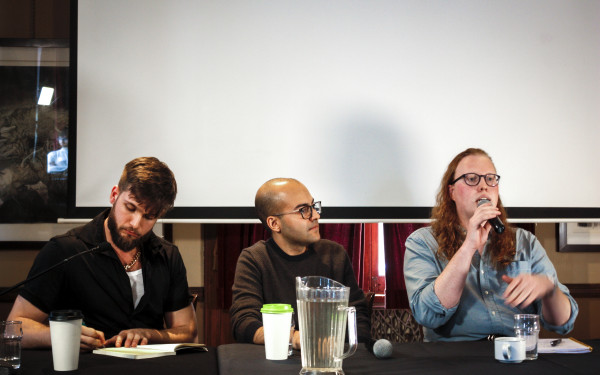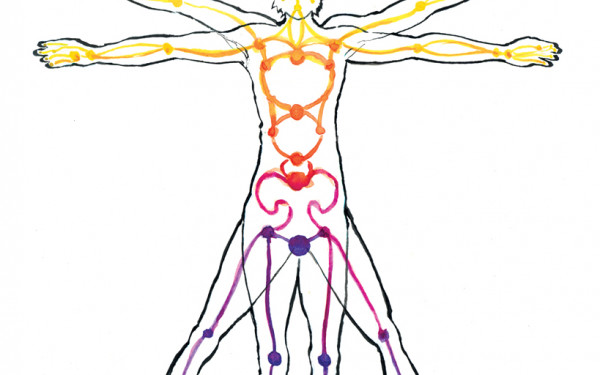Actively Queer
Queerobics Brings Aerobics to Safe Spaces
“I’m really good at tricking people into running, and I’m really good at tricking people into doing push ups,” said Shannon Herrick, founder of Queerobics.
Herrick has a difficult task: making physical activity something people enjoy, instead of something they begrudgingly check off their to-do lists. Her target group is people who identify as queer, gay, lesbian, bisexual, trans, gender-nonconforming or those looking for a non-judgmental space to work out.
Queerobics lessons started just over a month ago, and though turnout could be better, Herrick is hopeful things will pick up in the new year with resolutions to get fit.
Her concept of an alternative aerobics workout started in May, originally known as Work It Out, when she and friends worked out in parks for free.
Now, Herrick, a recent McGill undergraduate, hopes the classes can be part of new research about how to make physically active spaces open to non-straight and non-cis people.
There is little research comparing hetero and queer people on physical activity, Herrick said, but there have been studies on homophobia in team sports and physical education class. All of this can discourage queer youth from feeling confident in physically active spaces.
“It doesn’t have to be a gym, it can be a locker room, a field,” she said.
Non-heterosexual and non-gender conforming people may become ‘others’ and can be socially excluded in physical education classes, according to Heather Jane Sykes in the 2011 book Queer Bodies. Students who identified as queer told Sykes they would skip P.E. class and changing rooms to avoid being harassed.
These kinds of experiences in primary or high school can turn people off of physical activity when they get older, putting them at risk of preventable health problems, Herrick said.
“You go through this system, then you’re done, and you hate physical activity,” she said.
Non-hetero young adults commit one to three fewer hours of working out a week and are 46 to 76 per cent less likely to play team sports, according to a 2014 article published by the U.S. National Library of Medicine. The article attributed this to gender non-conformity and lower self-esteem in athleticism.
“It has nothing to do with who you choose to be intimate with,” Herrick said. “It’s just because of pre-existing systems of oppression, the way society works—those intervention programs and ideas of gender push you to the outside, especially when it comes to physical health.”
That’s changing, Herrick said, with evolving curricula that include queer issues. But for the generation that missed out on an open and queer-friendly health class, there’s still apprehension to incorporate physical activity in their life.
Herrick uses her background as an athlete to come up with aerobics programs. She worked as an Aquafit instructor and played in national competitions on McGill’s synchronized swimming team.
Other Montreal queer-friendly activities, such as Queer Tango and Queer Yoga, are more focused on creating a space for queer and differently-abled people, who aren’t as comfortable in typical tango and yoga classes.
“Queer tango offers a safe or unthreatening space for queers to penetrate dance scenes that, I guess, on the surface look uber heteronormative,” said Miriam Ginestier, who co-founded the Queer Tango group.
“We’re kind of queering tango,” Ginestier said. A lot of assumptions are engrained in the dance, she said, like “men lead, women follow.” Tango is also intimate and can be a flirty environment, so it’s important everyone is comfortable and open about their identities. Some hetero women participate in the group because they’ve had injuries that make it difficult to follow.
Alisha Mascarenhas started Queer Yoga to create a space for people to practice yoga poses, but who don’t feel welcome in most studios.
The yoga classes are also a place where a person’s gender isn’t assumed, which, for people who aren’t gender-normative or who don’t necessarily visibly fit into binaries, means not explaining their gender-identity when they’re trying to concentrate on their yoga practice.
“Trans folks who have come to class—they always have to be correcting people or addressing it in their day to day, and it’s a shitty thing to have to do that in a yoga space as well,” Mascarenhas said.
Mascarenhas started teaching Queer Yoga at the Centre for Gender Advocacy about a year ago, but has been teaching yoga for about three years. Classes are Fridays at noon. Queer Yoga lessons are offered as pay-what-you-can, because yoga can be financially inaccessible.
According to Herrick, Queerobics is about confronting gym culture, which often doesn’t provide a safe space and can promote unrealistic beauty standards. These spaces can also be financially and physically inaccessible.
“It’s really hard to deprogram that,” she said. “Healthy doesn’t [mean that you] have to be a fitness model.”
Part of Herrick’s program is building confidence for people who do choose to go the gym.
“Confidence and knowledge is key, because you can say, ‘I know how to squat, I know how to deadlift,’” Herrick said. “Then you have a baseline, so you can deal with all the bullshit and the stares.”
Herrick hopes to continue Queerobics and, through graduate studies, conduct participatory action research, which is community-based research that reflects and adjusts methods based on findings.
For now, Herrick is designing aerobics programs that sound less terrible.
“You need to do weird fun things,” she said. “Suicides, I don’t do that. It’s also a terrible fucking name.” Instead she replaces the sprinting exercises with something she calls “euphorias.”
“It’s similar, but you go and you have to be like a mermaid, but it’s actually technically harder than a suicide,” she said. “It’s weird, tagging on a different name or approaching it a different way so that all of a sudden you’re like, ‘I can’t believe you’re making me do star jumps.’”
Queerobics takes place Thursdays at 10 a.m. at the Centre for Gender Advocacy. Other times and dates are listed on the Queerobics Facebook group.

_900_603_90.jpg)
_600_832_s.png)



_1__600_375_90_s_c1.jpg)
_600_375_90_s_c1.jpg)